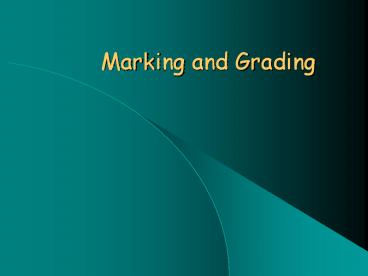Marking and Grading - PowerPoint PPT Presentation
1 / 20
Title:
Marking and Grading
Description:
College admissions officers. Employers. Grading and Marking. Three audiences are most important: ... Poor or incorrect grading procedures can have deleterious ... – PowerPoint PPT presentation
Number of Views:872
Avg rating:3.0/5.0
Title: Marking and Grading
1
Marking and Grading
2
Grading and Marking
- Primary function
- Clear communication to
- Pupils.
- Parents.
- Counselors.
- Other teachers.
- Other schools.
- College admissions officers.
- Employers.
3
Grading and Marking
- Three audiences are most important
- Parents.
- Students.
- School administration.
- Poor or incorrect grading procedures can have
deleterious consequences. - Can you think of some of these?
4
Critical Purpose of Grading and Marking
Communication
- Communication about the pupils academic
achievement. - Summary judgement about how well the student has
mastered instructional objectives (learning
targets). - Grades
- Should be concise without loss of information.
- Should minimize errors in interpretation.
- Should inform, not conceal or confuse.
5
Grading and Marking
- Incidental functions of grading
- Feedback.
- Motivation.
- Guidance.
- Should never be used for punishment or reward.
6
Grading as Judgement
- Grading requires Teachers judgement
- Teachers know their students best.
- Judgements are based on
- information about the student (test scores, book
reports, performance assessments, informal
assessments, etc.). - some basis of comparison for translating
information about the student into a grade. - Question Do we need the same information for ALL
students?
7
Possible Bases for Grading and Marking
- Consider the following bases for making decision
about students grades - Comparisons with aptitude or ability.
- Comparisons with improvement.
- Comparisons with effort.
- Comparisons with other students.
- Comparisons with standards.
- Combinations of grading bases.
8
Bases for Grading and MarkingComparisons with
Aptitude
- Give high grades to students who perform above
their ability. - Requires an estimate of ability.
- What is over-achievement?
- What is under-achievement?
- There are numerous flaws with basing grading and
marking on comparisons with ability.
9
Flaws Associated with Comparisons with Aptitude
- Estimates of ability tend to be informal and
unreliable. - Low correlation between (estimates of) ability
and achievement. - Regression to the mean
- Low ability kids always score closer to the group
average on achievement. - High ability kids always scores closer to the
group average on achievement. - Lower aptitude kids get lower scores on
achievement but receive higher grades. - Higher aptitude kids get higher scores on
achievement but receive lower grades.
10
Bases for Grading and MarkingComparisons with
Improvement
- Improvement Posttest Pretest
- Posttests and pretests may be informal
assessments. - Problems include
- We need to understand what this implies.
- Gain (difference) scores tend to be unreliable.
- The lower the correlation (between pre- and
post-) the more susceptible to regression
effects. - Negative correlation between initial status and
improvement. - Higher grades go to students who know less low
grades to students who know more.
11
Bases for Grading and MarkingComparisons with
Effort
- Typically used in elementary grades
- to manipulate motivation.
- to protect or foster self-esteem.
- Students who appear to learn easily seem less
deserving than those who struggle. - Requires sound measures of effort.
12
Bases for Grading and MarkingComparisons with
Other Students
- Grading on the curve.
- Fixed percentages of students get As, Bs, etc.
- Readily understood by parents, students, others.
- Appeals to common sense.
- For classroom assessment, grading on the curve
has several disadvantages.
13
Problems with Grading on the Curve
- A certain percentage must pass must fail.
- Setting percentages is arbitrary.
- Not particularly effective in communicating
achievement status. - Actual standards tend to fluctuate with class to
class performances. - Also looking for natural gaps in the
distribution of scores doesnt work.
14
Bases for Grading and MarkingComparisons with
Standards
- Students independent performances are judged.
- All students have potential for achieving the
highest grade. - Meaning of grades based on (clear) standards is
easily communicated. - The difficulty is in setting standards, which can
shift up or down without teachers awareness.
15
Combining Various Bases for Grading and Marking
Hodgepoge Grading
- Sometimes any one basis is seen as
unsatisfactory. - Achievement combined with effort is
commonespecially in elementary grades. - Often, teachers use whichever procedure yields
the highest grade. - All combinations reduce the effectiveness of
grades to communicate what it is that is being
graded.
16
What should a teacher do?
- There are no perfect solutions.
- Grading on the basis of preset, fixed standards
is probably best in terms of effective
communication about academic accomplishments. - However, setting standards is a difficult
undertaking. - It requires considerable reflection.
- Standards must be reasonable and obtainable.
17
When grading, answer these three questions
- Against what standard will I compare my pupils
performance? - What aspects of pupil performance will I include
in my grades? - How will different kinds of evidence be weighted
in assigning grades?
18
What about using zeros?
- One of the worst offenses in grading is the
indiscriminant use of zeros. Not completing an
assignment does not mean zero achievement or
learning. - James H. McMillan (1997). Classroom Assessment
Principles and Practice for Effective
Instruction, p. 317.
19
- Rarely does a zero in a grade book represent
actual performance on an assessment. This is
interesting, because that is exactly what a zero
for an academic grading component should
represent. Zeros should not be used for other
purposes because they distort the picture of the
students true performance. - Jo D. Gallagher (1993). Classroom Assessment for
Teachers. p. 419.
20
END

